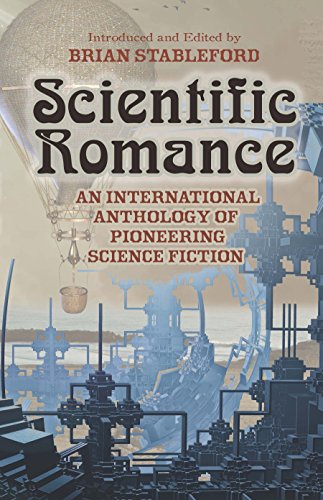| Home |
| Novels |
| Collections |
| Translations |
| Non-Fiction |
| Short Stories |
| Anthologies |

Before the term "science fiction" was adopted in the 1920s, there were "scientific romances," tales of amazing journeys beyond the limits of the known world. Jules Verne's imaginative novels of the mid-nineteenth century met with international success, whetting the public's appetite for fantastic fiction rooted in actual fact — a craving that H. G. Wells satisfied with his visionary stories.
This compilation presents more than two dozen early tales by Verne's and Wells's immediate predecessors, contemporaries, and descendants, focusing on the middle period, when the genre was at its most enterprising and exuberant. Originally published between 1835 and 1924, the stories offer early interpretations of the futuristic societies, rogue stars, rebellious machines, and other now-familiar themes of speculative fiction. Featured authors include Edgar Allan Poe, Nathaniel Hawthorne, Ambrose Bierce, H. G. Wells, Jack London, and Sir Arthur Conan Doyle, as well as lesser-known writers.
CONTENTS:
Introduction by Brian Stableford
The Conversation of Eiros and Charmion by Egar Allen Poe
A Heavenward Voyage by S Henry Berthoud
The Artist of the Beautiful by Nathaniel Hawthorne
What Was It? by Fitz-James O’Brien
The End of the World by Eugene Mouton
A Paradoxical Ode (After Shelley) by James Clark Maxwell
The Ablest Man in the World by Edward Page Mitchell
Josuah Electricmann by Ernest D’Hervilly
The Child of the Phalanstery by Grant Allen
The Salvation of Nature by John Davidson
Tornadres by J.-H. Rosny
Professor Bakermann’s Microbe by Charles Epheyre
In the Year Ten Thousand by Edgar Fawcett
The Revolt of the Machines by Émile Goudeau
For the Akhoond by Ambrose Bierce
The Philosophy of Relative Existences by Frank R. Stockton
June 1993 by Julian Hawthorne
The Dancing Partner by Jerome K. Jerome
The Conqueror of Death by Camille Debans
The Star by H. G. Wells
A Corner in Lightning by George Griffith
The Memory Cell by Walter Besant
The Shadow and the Flash by Jack London
The Gorilloid by Edmond Haraucourt
The Voice in the Night by William Hope Hodgson
The Singular Fate of Bouvancourt by Maurice Renard
The Horror of the Heights by Sir Arthur Conan Doyle
A Chronology of the Most Important Longer Works of Scientific Romance
Published Between 1830 and August 1914
Published by Dover Publications in January 2017
ISBN: 978-0-486-80837-6

